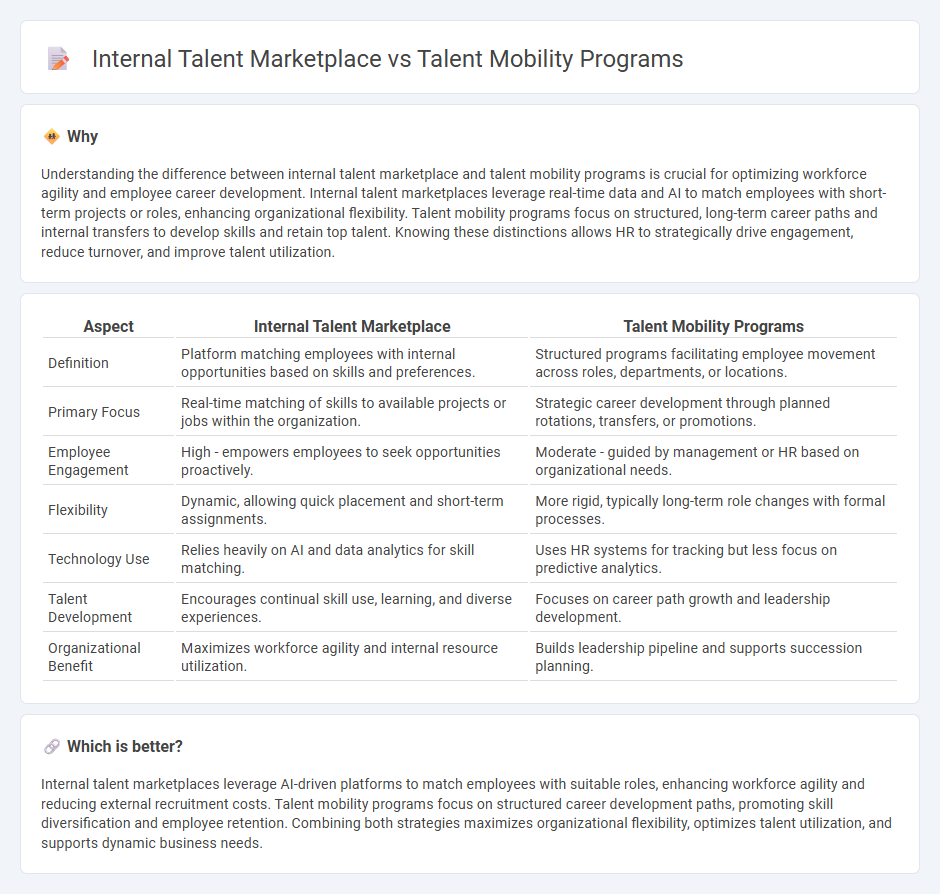
Internal talent marketplaces connect employees with open roles by leveraging skills and career aspirations within the organization, enhancing workforce agility and retention. Talent mobility programs focus on facilitating employee movement across departments or job functions to develop experience and align capabilities with strategic business needs. Explore how these approaches can transform your organization's talent management strategy.
Why it is important
Understanding the difference between internal talent marketplace and talent mobility programs is crucial for optimizing workforce agility and employee career development. Internal talent marketplaces leverage real-time data and AI to match employees with short-term projects or roles, enhancing organizational flexibility. Talent mobility programs focus on structured, long-term career paths and internal transfers to develop skills and retain top talent. Knowing these distinctions allows HR to strategically drive engagement, reduce turnover, and improve talent utilization.
Comparison Table
| Aspect | Internal Talent Marketplace | Talent Mobility Programs |
|---|---|---|
| Definition | Platform matching employees with internal opportunities based on skills and preferences. | Structured programs facilitating employee movement across roles, departments, or locations. |
| Primary Focus | Real-time matching of skills to available projects or jobs within the organization. | Strategic career development through planned rotations, transfers, or promotions. |
| Employee Engagement | High - empowers employees to seek opportunities proactively. | Moderate - guided by management or HR based on organizational needs. |
| Flexibility | Dynamic, allowing quick placement and short-term assignments. | More rigid, typically long-term role changes with formal processes. |
| Technology Use | Relies heavily on AI and data analytics for skill matching. | Uses HR systems for tracking but less focus on predictive analytics. |
| Talent Development | Encourages continual skill use, learning, and diverse experiences. | Focuses on career path growth and leadership development. |
| Organizational Benefit | Maximizes workforce agility and internal resource utilization. | Builds leadership pipeline and supports succession planning. |
Which is better?
Internal talent marketplaces leverage AI-driven platforms to match employees with suitable roles, enhancing workforce agility and reducing external recruitment costs. Talent mobility programs focus on structured career development paths, promoting skill diversification and employee retention. Combining both strategies maximizes organizational flexibility, optimizes talent utilization, and supports dynamic business needs.
Connection
Internal talent marketplaces drive talent mobility programs by providing a centralized platform where employees can access diverse job opportunities within the organization, enhancing workforce agility. These systems leverage AI-powered matching algorithms to align employee skills and career aspirations with internal openings, promoting continuous development and retention. Talent mobility programs benefit from this seamless integration by fostering skill diversification and succession planning, ultimately optimizing human resource management.
Key Terms
Talent Mobility Programs:
Talent mobility programs prioritize structured employee movement across departments or locations to enhance skill development, retention, and organizational agility. These programs often include formal rotations, cross-functional assignments, and international relocations, supporting career growth and matching company needs with employee potential. Explore how talent mobility programs can transform workforce strategy and drive competitive advantage for your business.
Workforce Planning
Talent mobility programs enable strategic workforce planning by facilitating employee movement across roles, departments, or locations based on skills and business needs, enhancing organizational agility and reducing skill gaps. Internal talent marketplaces leverage AI-driven platforms to match employees with project opportunities or roles, optimizing resource allocation and promoting continuous career development within the company. Explore how integrating these approaches can revolutionize your workforce planning strategy.
Career Pathing
Talent mobility programs facilitate employee movement across roles and departments to enhance skills and retain top talent, while internal talent marketplaces provide a dynamic platform for matching employees with available opportunities based on skills and career aspirations. Career pathing in talent mobility is often structured and department-driven, whereas internal talent marketplaces offer personalized, self-directed career development options. Explore how integrating both strategies can maximize career growth and organizational agility.
Source and External Links
The 5 Pillars of a Successful Talent Mobility Strategy and ... - Bridge - Talent mobility programs are most effective when built around five pillars: career pathing and recommended learning, job listings, project marketplaces, mentor marketplaces, and workforce analytics, all designed to help employees grow internally and meet organizational goals.
What is Talent Mobility? 3 Examples & Best Practices - TalentCards - Talent mobility programs systematically move employees into the right roles at the right time to boost retention, increase agility, align skills with business needs, and enhance employee development through continuous learning, career development, and technology use.
The dos and don'ts of talent mobility - WilsonHCG - Talent mobility programs facilitate employee internal movement across roles, functions, or geographies to close skill gaps, speed hiring, and improve retention, with data showing employees who move internally are more likely to stay with the company long-term.
 dowidth.com
dowidth.com